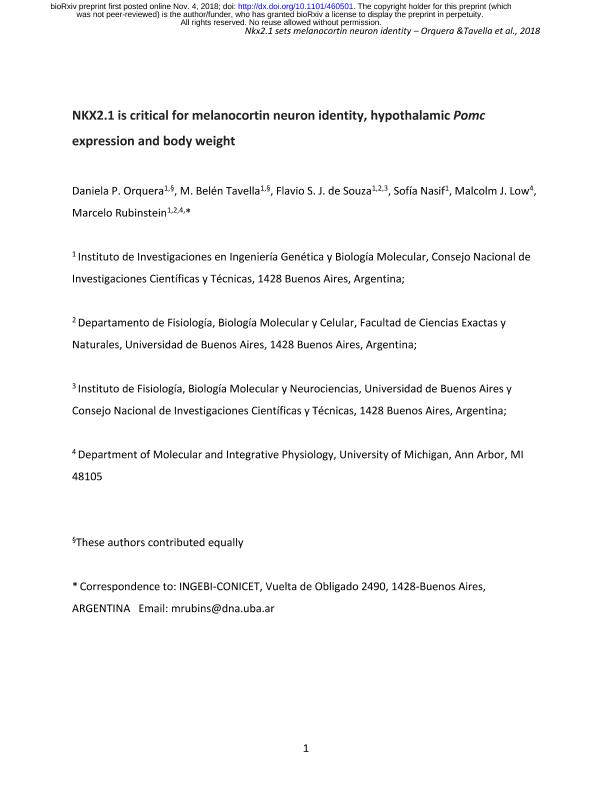Mostrar el registro sencillo del ítem
dc.contributor.author
Orquera, Daniela Paula

dc.contributor.author
Tavella, Maria Belen

dc.contributor.author
Silva Junqueira de Souza, Flavio

dc.contributor.author
Nasif, Sofia

dc.contributor.author
Low, Malcolm J.

dc.contributor.author
Rubinstein, Marcelo

dc.date.available
2020-12-22T13:34:18Z
dc.date.issued
2019-05
dc.identifier.citation
Orquera, Daniela Paula; Tavella, Maria Belen; Silva Junqueira de Souza, Flavio; Nasif, Sofia; Low, Malcolm J.; et al.; The homeodomain transcription factor NKX2.1 is essential for the early specification of melanocortin neuron identity and activates Pomc expression in the developing hypothalamus; Society for Neuroscience; Journal of Neuroscience; 39; 21; 5-2019; 4023-4035
dc.identifier.issn
0270-6474
dc.identifier.uri
http://hdl.handle.net/11336/121024
dc.description.abstract
Food intake is tightly regulated by a group of neurons present in the arcuate nucleus of the hypothalamus, which release Pomc-encoded melanocortins, the absence of which induces marked hyperphagia and early-onset obesity. Although the relevance of hypothalamic POMCneurons in the regulation of body weight and energy balance is well appreciated, little is known about the transcription factors that establish the melanocortin neuron identity during brain development and its phenotypic maintenance in postnatal life. Here, we report that the transcription factor NKX2.1 is present in mouse hypothalamic POMC neurons from early development to adulthood. Electromobility shift assays showed that NKX2.1 binds in vitro to NKX binding motifs present in the neuronal Pomc enhancers nPE1 and nPE2 and chromatin immunoprecipitation assays detected in vivo binding of NKX2.1 to nPE1 and nPE2 in mouse hypothalamic extracts. Transgenic and mutant studies performed in mouse embryos of either sex and adult males showed that the NKX motifs present in nPE1 and nPE2 are essential for their transcriptional enhancer activity. The conditional early inactivation of Nkx2.1 in the ventral hypothalamus prevented the onset of Pomc expression. Selective Nkx2.1 ablation from POMC neurons decreased Pomc expression in adult males and mildly increased their body weight and adiposity. Our results demonstrate that NKX2.1 is necessary to activate Pomc expression by binding to conserved canonical NKX motifs present in nPE1 and nPE2. Therefore, NKX2.1 plays a critical role in the early establishment of hypothalamic melanocortin neuron identity and participates in the maintenance of Pomc expression levels during adulthood.
dc.format
application/pdf
dc.language.iso
eng
dc.publisher
Society for Neuroscience

dc.rights
info:eu-repo/semantics/openAccess
dc.rights.uri
https://creativecommons.org/licenses/by-nc-sa/2.5/ar/
dc.subject
BODY WEIGHT REGULATION
dc.subject
CONDITIONAL MUTANT MICE
dc.subject
MELANOCORTINS
dc.subject
NEURON-SPECIFIC EXPRESSION
dc.subject
TRANSCRIPTION FACTOR
dc.subject.classification
Biología del Desarrollo

dc.subject.classification
Ciencias Biológicas

dc.subject.classification
CIENCIAS NATURALES Y EXACTAS

dc.subject.classification
Bioquímica y Biología Molecular

dc.subject.classification
Ciencias Biológicas

dc.subject.classification
CIENCIAS NATURALES Y EXACTAS

dc.title
The homeodomain transcription factor NKX2.1 is essential for the early specification of melanocortin neuron identity and activates Pomc expression in the developing hypothalamus
dc.type
info:eu-repo/semantics/article
dc.type
info:ar-repo/semantics/artículo
dc.type
info:eu-repo/semantics/publishedVersion
dc.date.updated
2020-11-13T20:49:08Z
dc.journal.volume
39
dc.journal.number
21
dc.journal.pagination
4023-4035
dc.journal.pais
Estados Unidos

dc.description.fil
Fil: Orquera, Daniela Paula. Consejo Nacional de Investigaciones Científicas y Técnicas. Instituto de Investigaciones en Ingeniería Genética y Biología Molecular "Dr. Héctor N. Torres"; Argentina
dc.description.fil
Fil: Tavella, Maria Belen. Consejo Nacional de Investigaciones Científicas y Técnicas. Instituto de Investigaciones en Ingeniería Genética y Biología Molecular "Dr. Héctor N. Torres"; Argentina
dc.description.fil
Fil: Silva Junqueira de Souza, Flavio. Consejo Nacional de Investigaciones Científicas y Técnicas. Instituto de Investigaciones en Ingeniería Genética y Biología Molecular "Dr. Héctor N. Torres"; Argentina. Universidad de Buenos Aires. Facultad de Ciencias Exactas y Naturales. Departamento de Fisiología, Biología Molecular y Celular; Argentina. Consejo Nacional de Investigaciones Científicas y Técnicas. Oficina de Coordinación Administrativa Ciudad Universitaria. Instituto de Fisiología, Biología Molecular y Neurociencias. Universidad de Buenos Aires. Facultad de Ciencias Exactas y Naturales. Instituto de Fisiología, Biología Molecular y Neurociencias; Argentina
dc.description.fil
Fil: Nasif, Sofia. Consejo Nacional de Investigaciones Científicas y Técnicas. Instituto de Investigaciones en Ingeniería Genética y Biología Molecular "Dr. Héctor N. Torres"; Argentina
dc.description.fil
Fil: Low, Malcolm J.. Michigan State University; Estados Unidos
dc.description.fil
Fil: Rubinstein, Marcelo. Consejo Nacional de Investigaciones Científicas y Técnicas. Instituto de Investigaciones en Ingeniería Genética y Biología Molecular "Dr. Héctor N. Torres"; Argentina. Universidad de Buenos Aires. Facultad de Ciencias Exactas y Naturales. Departamento de Fisiología, Biología Molecular y Celular; Argentina. Michigan State University; Estados Unidos
dc.journal.title
Journal of Neuroscience

dc.relation.alternativeid
info:eu-repo/semantics/altIdentifier/url/http://www.jneurosci.org/lookup/doi/10.1523/JNEUROSCI.2924-18.2019
dc.relation.alternativeid
info:eu-repo/semantics/altIdentifier/doi/http://dx.doi.org/10.1523/JNEUROSCI.2924-18.2019
Archivos asociados
